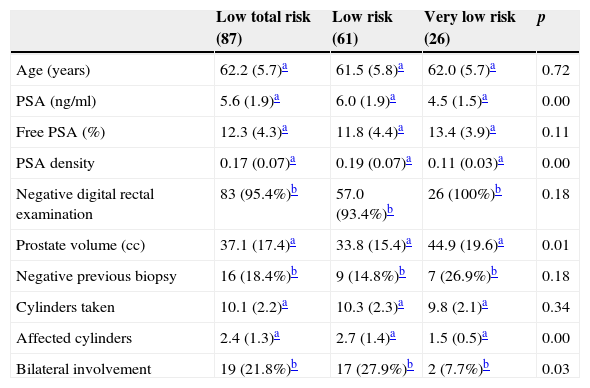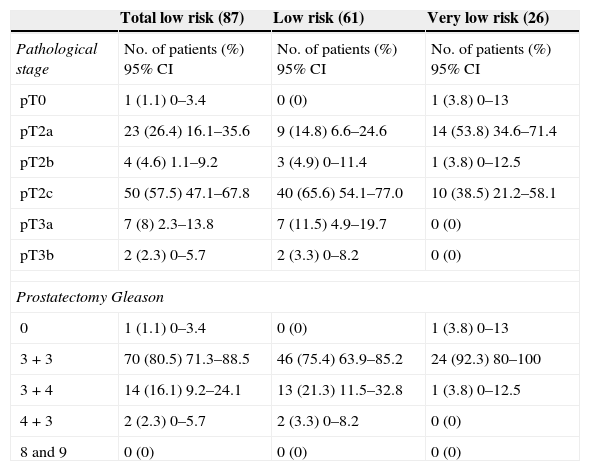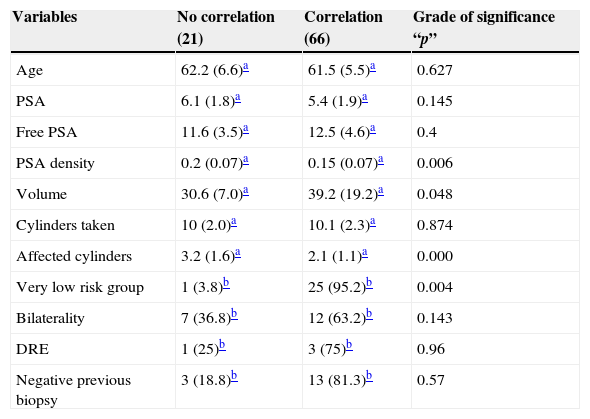To analyze the correlation between pathological data found in radical prostatectomy and previously performed biopsy in patients at low risk prostate cancer.
Material and methodsA descriptive, cross-sectional study was conducted to assess the characteristics of radical prostatectomies performed in our center from January 2012 to November 2014. The inclusion criteria were patients with low-risk disease (cT1c–T2a, PSA≤10ng/ml and Gleason score≤6). We excluded patients who had fewer than 8 cores in the biopsy, an unspecified number of affected cores, rectal examinations not reported in the medical history or biopsies performed in another center.
ResultsOf the 184 patients who underwent prostatectomy during this period, 87 met the inclusion criteria, and 26 of these had <3 affected cores and PSA density ≤.15 (very low risk). In the entire sample, the percentage of undergrading (Gleason score ≥7) and extracapsular invasion (pT3) was 18.4% (95% CI 10.3–27.6) and 10.35% (95% CI 4.6–17.2), respectively. The percentage of positive margins was 21.8% (95% CI 12.6–29.9). In the very low-risk group, we found no cases of extracapsular invasion and only 1 case of undergrading (Gleason 7 [3+4]), representing 3.8% of the total (95% CI 0–12.5). Predictors of no correlation (stage≥pT3a or undergrading) were the initial risk group, volume, PSA density and affected cores.
ConclusionsProstate volume, PSA density, the number of affected cores and the patient's initial risk group influence the poor pathological prognosis in the radical prostatectomy specimen (extracapsular invasion and Gleason score≥7).
Analizar la correlación entre los datos anatomopatológicos encontrados en prostatectomía radical y la biopsia previa realizada en pacientes con cáncer de próstata de bajo riesgo.
Material y métodosSe ha realizado un estudio descriptivo transversal para valorar las características de las prostatectomías radicales realizadas en nuestro centro desde enero de 2012 a noviembre de 2014. Los criterios de inclusión fueron pacientes con enfermedad de bajo riesgo (cT1c-T2a, PSA≤10ng/ml y Gleason≤6). Fueron excluidos aquellos con menos de 8 cilindros en la biopsia, número de cilindros afectos no especificados, tacto rectal no recogido en historia clínica o biopsia realizada en otro centro.
ResultadosDe las 184 prostatectomías realizadas en este periodo, 87 pacientes cumplían con los criterios de inclusión y 26 de estos presentaban<3 cilindros afectados y un PSAd≤0,15 (muy bajo riesgo). Encontramos en la muestra total un porcentaje de infragradación (Gleason ≥7) del 18,4% (IC 95%: 10,3–27,6%) y de afectación extracapsular (pT3) del 10,35% (IC 95%: 4,6–17,2%). El porcentaje de márgenes positivos fue del 21,8% (IC 95%: 12,6-29,9%). En el grupo de muy bajo riesgo no encontramos ningún caso de afectación extracapsular y un solo caso de infragradación (Gleason 7 [3+4]) representando un 3,8% del total (IC 95%: 0-12,5%). Resultaron ser variables predictoras de no correlación (estadio≥pT3a o infragradación) el grupo de riesgo inicial, volumen, PSA densidad y cilindros afectados.
ConclusionesEl volumen prostático, el valor del PSA densidad, el número de cilindros afectados y el grupo de riesgo inicial del paciente influyen en la aparición de datos de mal pronóstico anatomopatológico en la pieza de prostatectomía radical (afectación extracapsular y Gleason≥7).









